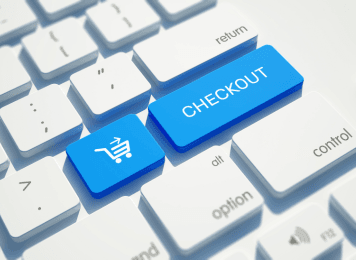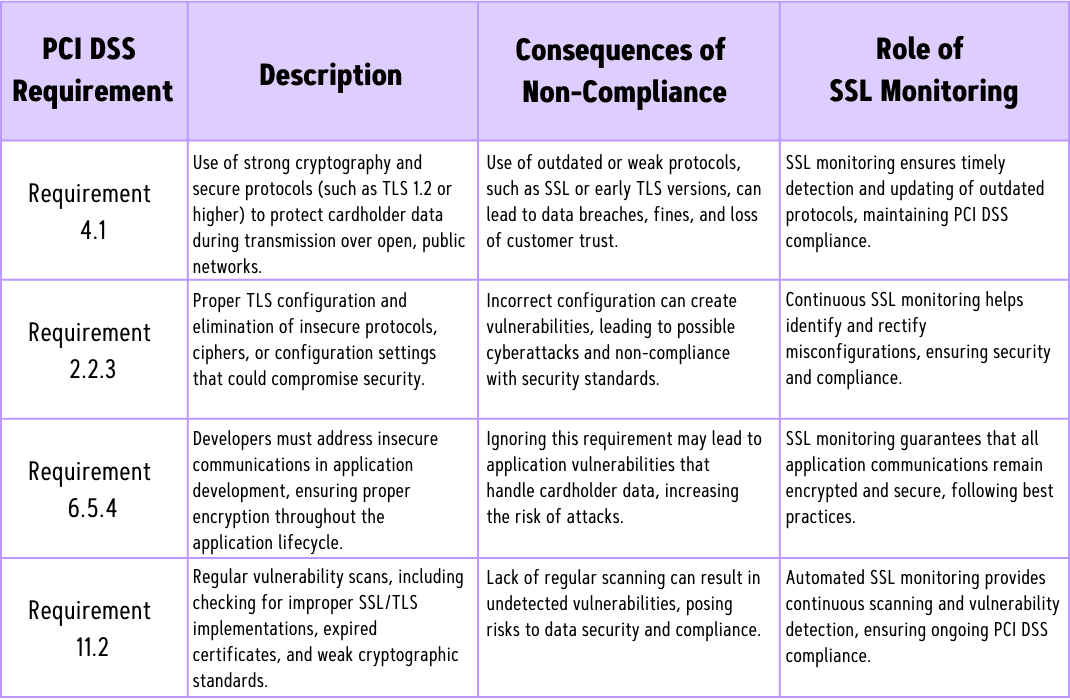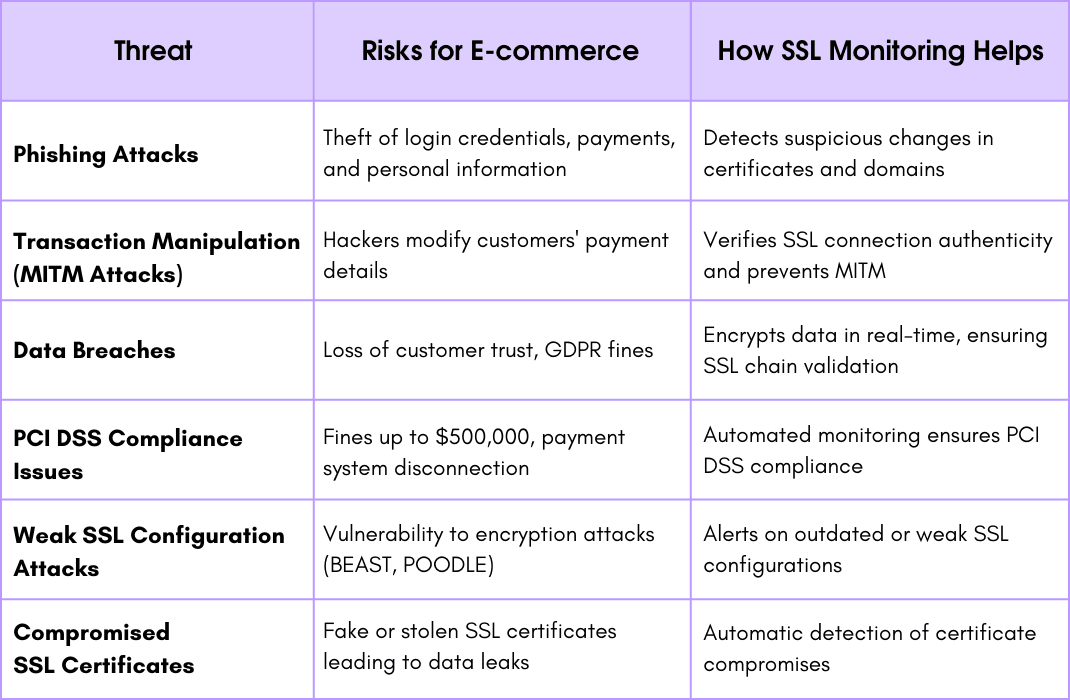In today's digital marketplace, e-commerce security has become the cornerstone of successful online businesses. Every day, millions of customers share sensitive personal and financial information through online transactions, trusting that their data remains protected from increasingly sophisticated cyber threats. According to Statista's 2024 Digital Market Outlook, global e-commerce sales are projected to reach $6.3 trillion by the end of 2025, representing a 47% increase since 2021. With this explosive growth, cybersecurity incidents targeting retail businesses have surged by 63% in the same period, as reported in the 2024 Retail Security Trends Report by Trustwave. SSL monitoring stands as the vigilant guardian of this trust, ensuring that the pathway between customers and e-commerce platforms remains secure, encrypted, and impervious to malicious actors seeking to exploit vulnerabilities in the payment process. For online retailers, implementing robust SSL certificate monitoring isn't just good practice—it's essential for protecting customer data, preventing fraud, and maintaining the integrity of every online transaction that flows through your digital storefront.
Securing the Checkout: How SSL Monitoring Protects E-commerce Transactions
Nadiia Sidenko
2025-03-13

Securing the Checkout: How SSL Monitoring Protects E-commerce Transactions
The Stakes are High: E-commerce and Online Security
The explosive growth of e-commerce has created a parallel growth in cyber threats targeting online retailers and their customers. When shoppers enter their credit card details, addresses, and personal information during checkout, they're placing extraordinary trust in the security infrastructure of your website. A single data breach can devastate both customer confidence and your business reputation, leading to significant financial losses and regulatory penalties.
According to recent industry reports, e-commerce businesses experience more attempted breaches than any other sector, with attacks specifically targeting payment gateways and checkout processes where valuable financial data is exchanged. This underscores why SSL certificates are crucial for your website, providing the fundamental encryption layer that secures data transmission.
The Unique Challenges of E-commerce Security
E-commerce platforms face distinct security challenges that make SSL monitoring particularly vital:
Protecting Sensitive Customer Data
Online retailers process and store vast amounts of sensitive customer information, from credit card details to personal addresses and purchase histories. This treasure trove of data makes e-commerce sites prime targets for cybercriminals. Effective SSL monitoring ensures that data remains encrypted during transmission, preventing unauthorized access even if communications are intercepted.
Maintaining PCI DSS Compliance
For businesses accepting credit card payments, compliance with Payment Card Industry Data Security Standard (PCI DSS) requirements is non-negotiable. Valid SSL certificates are a cornerstone of PCI DSS compliance, and continuous monitoring ensures you maintain this compliance without interruption. Without proper SSL monitoring, certificates can expire unnoticed, immediately putting your business out of compliance and at risk of penalties.
The PCI DSS standard specifically addresses SSL requirements in several key sections:
- Requirement 4.1: Requires the use of strong cryptography and security protocols (such as TLS 1.2 or higher) to safeguard sensitive cardholder data during transmission over open, public networks.
- Requirement 2.2.3: Mandates implementation of proper TLS configuration and elimination of insecure protocols, ciphers, or configuration options that could compromise security.
- Requirement 6.5.4: Requires developers to address insecure communications in application development, ensuring proper encryption is maintained throughout the application lifecycle.
- Requirement 11.2: Necessitates regular vulnerability scans that include checking for improper SSL/TLS implementations, expired certificates, and vulnerable cryptographic standards.
According to the PCI Security Standards Council, "SSL and early TLS are not considered strong cryptography and cannot be used as a security control after June 30, 2018." This emphasizes the importance of not just having SSL certificates, but ensuring they implement the latest secure versions and protocols.

Many retailers don't realize that an SSL certificate is not forever, making monitoring essential to maintain continuous protection.
Building and Preserving Customer Trust
The padlock icon and "https://" prefix have become powerful trust signals for online shoppers. When customers see these indicators, they proceed with confidence. Conversely, browser warnings about insecure connections create immediate alarm and shopping cart abandonment. SSL monitoring prevents these trust-breaking scenarios by ensuring certificates remain valid and properly implemented.
How SSL Monitoring Safeguards E-commerce Transactions
SSL monitoring serves as a multi-layered defense system for your e-commerce platform:
Preventing Phishing Attacks
Sophisticated phishing operations often create convincing replicas of legitimate e-commerce sites to steal customer credentials. A properly implemented and monitored SSL certificate helps customers verify they're on the authentic website. Extended Validation (EV) certificates, which require rigorous verification of business identity, provide even stronger protection against phishing attempts.
Securing Credit Card Information
The primary target for most e-commerce attacks is credit card data. SSL encryption ensures that this information remains scrambled and unreadable during transmission between the customer's browser and your server. Continuous monitoring verifies this encryption remains in place and uses the latest security protocols, protecting against evolving threats.
Protecting Against Man-in-the-Middle Attacks
In man-in-the-middle attacks, hackers position themselves between customers and legitimate websites, intercepting and potentially altering communications. Proper SSL implementation verified through monitoring prevents these attacks by authenticating both ends of the connection and encrypting all data in transit.
Some website owners make critical mistakes with their SSL certificates that can create vulnerabilities despite having certificates installed.
Ensuring Data Integrity
Beyond preventing data theft, SSL monitoring also ensures data integrity—verifying that information hasn't been altered during transmission. This is particularly important for order details, shipping information, and payment amounts.

Key Features of E-commerce SSL Monitoring Tools
Effective SSL monitoring solutions for e-commerce should include:
Real-time SSL Certificate Status Checks
Automated systems that continuously verify certificate validity, expiration dates, and proper implementation across all pages involved in the checkout process are essential. These systems should check not just the main domain but all subdomains and third-party services integrated into your shopping experience.
Automated Alerts and Notifications
Proactive notification systems alert technical teams before certificates expire, when configuration issues arise, or when potential security vulnerabilities are detected. The best systems provide ample lead time to address issues before they impact customers.
PCI DSS Compliance Reporting
Comprehensive monitoring tools should generate reports that demonstrate SSL compliance for PCI DSS audits, documenting the continuous protection of cardholder data environments.
Integration with E-commerce Platforms
Seamless integration with major e-commerce platforms like Shopify, WooCommerce, and Magento ensures all aspects of your online store remain protected, including product pages, shopping carts, and checkout processes.
How to Implement SSL Monitoring on Your E-commerce Website
Setting up effective SSL monitoring doesn't have to be complicated. Here's a step-by-step approach to implementing robust protection for your online store:
1. Assess Your Current SSL Implementation
Begin by conducting a comprehensive audit of your existing SSL certificates:
- Identify all domains and subdomains requiring SSL protection
- Document certificate types, issuers, and expiration dates
- Verify that all checkout pages and payment forms are secured
- Check for mixed content warnings (HTTP elements on HTTPS pages)
2. Choose the Right Monitoring Solution
Select an SSL monitoring solution that matches your business needs:
- For smaller e-commerce sites: Consider automated tools with basic notification features
- For mid-sized operations: Look for solutions with dashboard reporting and integration capabilities
- For enterprise e-commerce: Implement comprehensive monitoring with advanced threat detection
Many business owners find that partnering with experts like MySiteBoost provides the most comprehensive protection, as their specialized SSL monitoring services handle the technical complexities while you focus on running your business.
3. Configure Monitoring Parameters
Set up your monitoring system with appropriate parameters:
- Establish monitoring frequency (daily checks are recommended for e-commerce)
- Configure multiple notification channels (email, SMS, dashboard alerts)
- Set up escalation protocols for critical issues
- Implement threshold alerts for certificate expiration (30, 15, and 7 days before expiry)
4. Integrate with E-commerce Platform
Ensure your monitoring solution works seamlessly with your e-commerce platform:
- Install any required plugins or extensions
- Configure API connections if applicable
- Verify that checkout processes are correctly monitored
- Test the system by simulating certificate issues
5. Establish Response Protocols
Create clear procedures for addressing SSL-related alerts:
- Assign responsibility for addressing different types of alerts
- Document the certificate renewal process
- Create backup plans for emergency certificate issues
- Establish communication templates for notifying customers if needed
For businesses without dedicated IT security staff, MySiteBoost's SSL monitoring service offers 24/7 coverage with expert response teams who can address issues before they impact your customers or sales.
Best Practices for E-commerce SSL Monitoring
To maximize your security posture:
Regularly Reviewing SSL Configurations
Beyond monitoring certificate validity, periodically review your SSL configuration to ensure you're using the strongest encryption protocols available and have disabled outdated, vulnerable protocols. This prevents attackers from forcing connections to use weaker encryption methods.
Implementing Multi-Factor Authentication (MFA)
While SSL secures data in transit, multi-factor authentication adds another crucial security layer for account access. Implement MFA for both customer accounts and administrative access to your e-commerce platform.
Many common myths about SSL certificates lead to misunderstandings about what additional security measures are needed.
Staying Informed About Emerging Threats
The cybersecurity landscape evolves rapidly. Maintain an active security posture by subscribing to vulnerability alerts and industry security bulletins. SSL monitoring should be part of a broader security strategy that adapts to new threats.
Real-World SSL Failures and Their Impact on E-commerce
The consequences of SSL failures in e-commerce are well-documented across the industry. Let's examine the documented patterns and impacts:
Certificate Expirations and Their Measurable Impact
A study published by Ponemon Institute titled "The Impact of Certificate-Related Outages" reveals that unplanned application downtime due to security certificate expirations costs businesses an average of $15 million annually across their IT environments. E-commerce platforms are particularly vulnerable during peak shopping seasons, with 74% of organizations experiencing significant outages caused by expired certificates within a two-year period.
These findings reinforce why SSL expiry can significantly impact website traffic and SEO, creating both immediate and long-term business consequences.
The Documented Cost of E-commerce Security Breaches
According to the IBM Security Cost of a Data Breach Report, the retail industry faces an average cost of $3.28 million per data breach incident, with compromised customer PII (Personally Identifiable Information) being the most expensive type of record lost. The report further identifies improper SSL/TLS configurations among the common vulnerability factors that contribute to these breaches.
For e-commerce businesses, these costs include not just remediation expenses but also lost customer trust and potential regulatory fines.
Vulnerabilities in Payment Processing Systems
The Verizon Data Breach Investigations Report (DBIR) highlights that 24% of data breaches specifically target e-commerce payment systems, with web application attacks remaining the predominant pattern. Many of these attacks exploit vulnerabilities in the encryption layer that proper SSL monitoring would detect and prevent.
This makes continuous SSL monitoring a critical defense mechanism for securing online transactions and protecting sensitive customer payment information.
Frequently Asked Questions About SSL Monitoring for E-commerce
How often should I check my e-commerce site's SSL certificate?
For e-commerce websites handling sensitive customer and payment information, daily automated checks are strongly recommended. While manual checks can be performed weekly, automated SSL monitoring services provide continuous oversight to detect issues immediately as they arise, rather than discovering problems after they've already impacted customers or sales.
What happens if my SSL certificate expires during a busy sales period?
If your SSL certificate expires, browsers will immediately display warning messages to all visitors attempting to access your site, effectively blocking them from completing purchases. During high-volume sales periods like Black Friday or holiday shopping seasons, even a few hours of downtime can result in significant revenue loss and damage to customer trust. Proactive monitoring prevents these scenarios by alerting you well before expiration.
Does SSL monitoring affect my website's performance or loading speed?
Properly implemented SSL monitoring has no noticeable impact on website performance or loading speed. Modern monitoring solutions work in the background, checking certificate status without affecting the user experience. In fact, by ensuring your SSL implementation remains optimized, monitoring can help prevent performance issues that might arise from improper certificate configurations.
How does SSL monitoring help with Google search rankings?
Google has confirmed that HTTPS is a ranking signal in their algorithm, giving a slight advantage to secure sites. More importantly, when SSL certificates expire or have problems, Google Chrome and other browsers display prominent warnings that dramatically increase bounce rates. These high bounce rates negatively impact SEO performance. Continuous SSL monitoring ensures your site maintains its security status and avoids these SEO penalties.
Can I monitor SSL certificates for multiple domains and subdomains?
Yes, comprehensive SSL monitoring solutions can track certificates across multiple domains, subdomains, and even third-party services integrated with your e-commerce platform. This is particularly important for larger e-commerce operations that may use different domains for various aspects of their business (main store, blog, support portal, etc.) or that operate multiple branded storefronts.
Conclusion
SSL Monitoring as a Cornerstone of E-commerce Security
In the high-stakes world of online retail, SSL monitoring isn’t just a best practice—it’s a fundamental necessity for protecting both business operations and customer trust. As more transactions shift online and regulatory requirements tighten, businesses that fail to implement continuous SSL monitoring risk financial losses, compliance violations, and irreversible damage to their reputation.
Rather than treating SSL monitoring as a technical formality, businesses should view it as a proactive defense against sophisticated cyber threats that target valuable payment and personal data. By ensuring encryption remains intact, preventing expired certificates, and securing checkout processes, retailers can strengthen their cybersecurity posture and provide a frictionless, secure experience for customers.
A failure to monitor SSL certificates can have serious SEO consequences, as browsers may label the site as "Not Secure," leading to increased bounce rates and lower rankings. If you want to understand how SSL certificate expiration impacts website traffic and search engine visibility, take a look at our detailed breakdown in SSL Expiry and Its Effect on Website Traffic and SEO.
SSL Monitoring Checklist for E-commerce Businesses
To maintain a secure and compliant online store, follow these key steps:
- Regularly review SSL configurations to prevent vulnerabilities and misconfigurations.
- Set up automated SSL monitoring to track expiration dates and security status.
- Ensure TLS 1.2 or higher is enforced across all transactions.
- Conduct periodic security audits to meet PCI DSS compliance requirements.
- Check for mixed content errors that may compromise encryption.
- Enable multi-factor authentication (MFA) for admin access to SSL settings.
- Train staff on emerging SSL threats and phishing tactics targeting SSL security.
By implementing these best practices, businesses can reduce security risks, maintain customer confidence, and prevent revenue loss caused by SSL failures. Staying ahead of SSL vulnerabilities isn’t just about protecting data—it’s about ensuring the long-term growth and stability of an e-commerce brand.
Securing the Checkout: How SSL Monitoring Protects E-commerce Transactions
The Stakes are High: E-commerce and Online Security
The Unique Challenges of E-commerce Security
How SSL Monitoring Safeguards E-commerce Transactions
Key Features of E-commerce SSL Monitoring Tools
How to Implement SSL Monitoring on Your E-commerce Website
Best Practices for E-commerce SSL Monitoring
Real-World SSL Failures and Their Impact on E-commerce
Frequently Asked Questions About SSL Monitoring for E-commerce
Conclusion